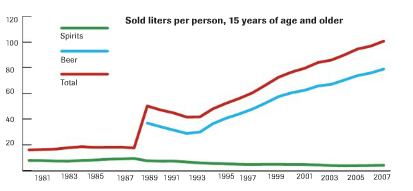Icelanders are not the kind of people who go to a pub to drink a beer or two over the course of an evening spent chatting with friends. Quite the contrary, they are the kind of people who head to the pubs long after the evening has passed, and their intention is to drink themselves into oblivion. To understand this behaviour, we spoke to historian Stefán Pálsson, who teaches at Iceland’s Beer School and knows a lot about Icelandic drinking culture in the twentieth century.
Much like other Western countries at the turn of the century, Iceland had its period of prohibition. The decision was made in the nation’s first referendum in 1908, with 60% voting in favour of the ban. It took parliament four years to pass the law, which then gave people three years—until January 1, 1915—to finish their liquor. Officially speaking, the dry spell then lasted until 1933, when 60% of the nation voted in a second referendum to lift the ban.
However, when the ban was lifted, beer was notably left out. Stefán Pálsson says the reason is unclear, but it seems that Icelandic goal-oriented drinking culture—drinking to become dead drunk—at least partially explains why beer wasn’t made legal until 1989. “Today people are rewriting the story, giving the impression that everyone really wanted beer, but a few boring politicians were holding us back,” Stefán says, “but that was certainly not the case.”
BEER IS LEFT OUT
So beer was left out for no good reason?
Well, some argue that this was to soften the blow to the temperance movement: You lost your ban, but at least beer is still banned. Others argue that it may just have been an error when the regulation was drawn up, that beer was simply forgotten and then nobody could be bothered to change it afterwards.
I actually blame the doctors who could prescribe legally imported alcohol to patients during prohibition. So if you had chest pains, the doctors could say, ‘Okay, you need whiskey’ or if you had a neurotic disorder, perhaps it was gin. Somehow, however, the doctors never had the imagination to prescribe beer for anything. So, since there was no legal import of beer in place at the time, it was much easier to leave it out.
The strange thing is that nobody really complained. You would think that someone would at least have written to the papers when prohibition was dropped, asking ‘Where is my beer?’ But this did not happen.
GOAL-ORIENTED DRINKING
Were people just unfamiliar with beer then?
I think that when it came to alcohol, Icelanders were very goal-oriented: men drank alcohol to become drunk and get into fights with each other. So you would have your flask with liquor in your pocket and there seemed to be very little demand for beer. And this was for a very long time socially acceptable, though it has become more taboo today.
Also, this Danish culture of constantly drinking light lager during the day was frowned upon. While it was socially acceptable to become terribly drunk every weekend, or at least every now and then, you really had a problem if you were drinking socially on a weekday or even at lunchtime.
How and when did this change?
In the mid to late ’70s, Icelanders began for the first time to go abroad as tourists, traveling to sunny coasts. While it used to be that people who went abroad were upper class or had a purpose, work related or had to do with their studies, the average Icelander could afford to be drunk in Spain for three weeks, and this really brought in beer culture to Iceland.
BEER CULTURE IS BORN
But it was still illegal to sell beer in Iceland at this point…
Right, so in the early ’80s you started to see Icelandic pubs selling ‘bjórlíki, which was basically vodka mixed with Pilsner. You had places like Gaukurinn trying to look like an English-themed pub selling this nasty mix of Pilsner and hard liquor, and all these pubs pretended to have the secret ingredient that made this taste like delicious beer.
Obviously you’d think this wasn’t allowed in a country with beer prohibition, but this went to court and the courts decided that this ‘bjórlíki’ was actually a cocktail. They were not brewing beer, but rather mixing something that was supposed to taste like beer.
At this point it was just a matter of time, and on March 1, 1989, the ban was dropped. Interestingly, opinion polls at the time suggest that the legislation would not have succeeded had it gone to referendum…
A PROLIFERATION OF PUBS
Did drinking culture change after the ban was lifted?
Nightlife had very much been restricted to weekends. Clubs would book concerts with people buying tickets to dance and drink lots of alcohol. The idea was not to pop into a pub or a café to see if you saw someone you knew and then continue to the next pub.
So beer really led to a growth in pub culture. The number of small pubs and restaurants and cafes has grown ridiculously since the beer ban was lifted. In a way, I think that Kaffibarinn in the early ’90s and Café Au Lait, where I think Nonnabiti is now, were probably the first examples of really crowded, tiny, pubs, which were seen as the place to be.
Then there was also the fact that Kringlan—Iceland’s first shopping mall—opened in 1987. It had a devastating effect on commerce for downtown shops. The city centre went into a steep decline and property value dropped, which meant that you could sustain a pub or a café where you could not in the past.
AND MORE DRINKING
Now, Iceland’s nightlife is pretty infamous. Icelanders are known to go out and drink themselves silly. Why don’t we have a more refined beer drinking culture?
It’s difficult to say, but the pub is not traditionally the same social institution as it is in many other countries. It takes decades to change that… If you go to the countryside you’ll see how the scene used to be here in Reykjavík. Locals watch television weekdays and go out on weekends to see a band play, and there will be lots of drinking, dancing, and some people fighting. In Reykjavík, however, we are moving more in the direction of having something more European.
But it’s not quite there yet?
No, it’s not quite there yet, and perhaps instead of replacing the heavy weekend drinking, the casual beer drinking during the week is simply an addition. The level of alcohol consumption has been rising very rapidly in most Western countries, but especially here in Iceland. Specialists in the field are worried about this trend.

Buy subscriptions, t-shirts and more from our shop right here!
















